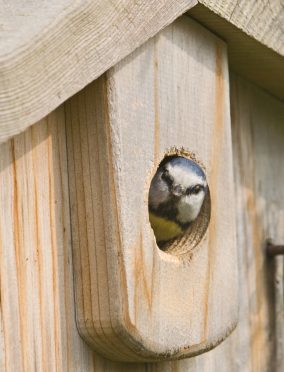With springtime fast approaching, people across Scotland are being urged to dust off their muddy wellies and get back into the garden to put up a nest box in time for breeding season.
Boxes shaped like caravans, farmhouses, eggs and even windmills are on sale as nesting sites for garden birds, but RSPB Scotland is warning that attractive or elaborate boxes are not necessarily safe or effective. In some cases, unsuitable nest boxes could even lead to birds being put in danger.
The wildlife charity is asking people to avoid purchasing or making these potentially dangerous boxes, and instead ensure they choose the right shape, size and material to suit their garden birds.
Materials and designs that might look attractive, such as ceramics and bright colours, are completely unsuitable as they’re poorly insulated and do not make the box conspicuous to predators.
Those with metal roofs retain too much heat and can have fatal effects for baby birds on warm, sunny days. Metal and plastic nest boxes also suffer from condensation, causing baby birds to get damp and cold.
Ben Andrew, RSPB wildlife advisor, said: “It’s crucial that people put up nest boxes to help our garden birds, especially those in decline like house sparrows and starlings. Rather than choosing unusual designs and materials, people should stick to traditional, wooden nest boxes – they really are the best and often the most cost effective.
“It’s also really important to make sure boxes are sited in the correct place. This depends on the species the box is intended for but there’s lots of information on our website.
“People tend to forget that a nest box will eventually contain tiny, helpless, vulnerable baby birds so the appearance of the box should be the last thing on your mind.”
RSPB Scotland is offering advice on what is and isn’t suitable:
Nest boxes should be:
Robust – they are out in all weather and need to be strong and fit for purpose
Waterproof – they need to be treated with a water-based preservative
Have the correct hole-size – if too large, predators will get inside and rain/wind will get into the box
Safe – no dangerous sharp edges, protruding nails or staples, unnecessary fixtures or small gaps which may harm or trap birds
Have good insulation – wood or woodcrete is usually the best material
Have no perches
They should not be:
Brightly coloured – the less conspicuous the better
Made from flimsy material – many boxes fall apart when weight is put inside
Too shallow – young birds could leave prematurely by falling out
Too deep – young birds may have problems getting out when they are ready
Too smooth on the inside – slippery material will also make it difficult for young birds to get out
Have gaps – rain and cold air will get in and cause young birds to get cold and damp
For more advice and a step-by-step guide on making your own nest box, visit: www.rspb.org.uk/ makeahomeforwildlife
